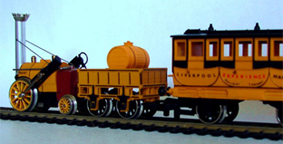Locomotive Class
Rocket
 Class: Rocket
Class: Rocket
Type: Steam
Designer: George Stephenson
Weight: ---
Purpose: Passenger
Information: In October 1829; George Stephenson’s Rocket won the £500.00 prize awarded the “Best Travelling Locomotive”. This successful design became the blue-print for subsequent designs of steam locomotion through the end of steam traction for nearly 150-years.
Details: In October 1829; George Stephenson assisted by son Robert introduced the Rocket to an assembled crowd at what became known as the famous Rainhill Trials held by the Liverpool and Manchester Railway Company. A £500.00 prize was awarded the winning design for innovation and capability. The purpose of the trial was to determine whether the formative railway would use stationary steam or self-propelled locomotives for movement of rail traffic over the route.
Nobody could for-see at the time, but Rocket was to become the blue-print for all conventional steam traction designs for nearly 150-years.
Rocket was built in Newcastle Upon Tyne at the Forth Street Works of Robert Stephenson and Company. Conventional thinking at the time opted for a single water cooled boiler tube; whilst the Rocket design consisted of 25-individual copper tubes running the length of the boiler thereby increasing heat transfer and operating efficiency. Although generally accepted credit for the over-all design is associated with George and son Robert Stephenson; it is believed Henry Booth, company Treasurer actually suggested the multi-tube boiler approach for the design.
Rocket had two cylinders set at 35-degrees from the horizontal, with the pistons driving the front wheels. Previous designs typically utilized vertical cylinders providing a lurching motion as the locomotive moved. After the trials Rocket was modified so that the cylinders were relocated to the more conventional horizontal position, further improving ride characteristics.
After several days of trials, Rocket was the clear winner. The other three contenders all failed mechanically during the evaluations. It is estimated a crowd of 15,000 people assembled to see the spectacle. To their delight Rocket performed admirably, hauling a load of 20-tons at a consistent 10-MPH. Running light the locomotive was capable of achieving a top speed of 24-MPH.
During her working life, Rocket saw many modifications. By 1862 it was with-drawn and donated to the Patent Office Museum in London for preservation. Today the original exists in the Science Museum in Kennsington. Due to the modifications received during her working career the locomotive bears little resemblance to the winner of the Rainhill Trials.
Several working replicas of the winning design have been produced. The first reputedly for a 1923 Buster Keaton film titled “Our Hospitality”. It has since featured in several other films. The where-about or existence of this replica today is unknown. A better known replica was produced in 1979 for the 150th anniversary of the Rainhill Trials and currently resides at the National Railway Museum in York.
John Faulkner
Rocket Releases (3)
| MODEL | NO. | LIVERY |
|---|---|---|
| Stephensons Rocket | None | --- |
| Stephensons Rocket Train Pack | --- | --- |
Stephenson’s Rocket OO Scale Presentation Pack

Released:
1982
|
None | --- |
Rocket Images (3)

Stephensons Rocket None

Stephensons Rocket Train Pack ---

Stephenson’s Rocket OO Scale Presentation Pack None


















